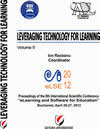TRADE-OFFS IN DEVELOPING HIGHLY INTERACTIVE MLEARNING CONTENT USING THE CURRENTLY AVAILABLE DEVELOPMENT PLATFORMS
TRADE-OFFS IN DEVELOPING HIGHLY INTERACTIVE MLEARNING CONTENT USING THE CURRENTLY AVAILABLE DEVELOPMENT PLATFORMS
Author(s): Adriana Mălureanu, Mihai Hazi, Adrian BarbuSubject(s): Education
Published by: Carol I National Defence University Publishing House
Keywords: Smart-phone capabilities; mobile development trade-offs
Summary/Abstract: The current day smart-phone is packed with a great assortment of sensors (ambient light, proximity, GPS, accelerometer, compass, gyro) and input modalities (touch, camera, microphone). This set of capabilities has spurred tens of thousands of developers to publish hundreds of thousands of mobile applications. The apple app store and the android market sum a total app download count of over 20 billion. How many of these apps have an mLearning focus and what sort of capabilities do they currently employ? What are some successful use cases extracted from this short market analysis? Considering the rapidly expanding mobile software and hardware space e-learning also has to adapt and move to this new medium. Most of the highly interactive desktop e-learning content has been traditionally developed using Adobe Flash. Does Flash still hold up in the mobile context or do the developers have take up HTML5 and/or native development for this type of content? This paper strives to give an answer to these questions by performing a short app markets analysis and developing an example app for a highly interactive use-case using three combinations of platforms and tools: flash/air, native and a mixed solution. The stumbling blocks encountered, and trade-offs made are expanded upon. Factors like the relative ease of implementation, the speed of deployment, multiplatform reach and app performance are also analyzed and trade-off points identified. As a final step conclusions are drawn as to the best path to choose for present day versus future development of highly interactive mLearning experiences.
Journal: Conference proceedings of »eLearning and Software for Education« (eLSE)
- Issue Year: 8/2012
- Issue No: 02
- Page Range: 144-149
- Page Count: 6
- Language: English

